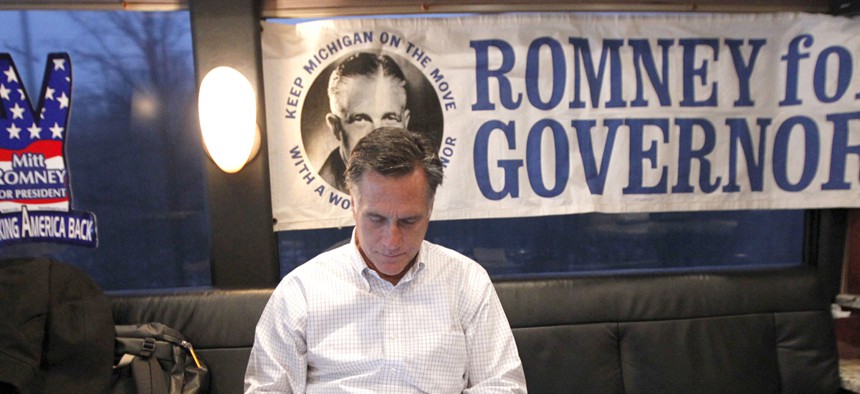Obama, Romney aren’t all that sociable on social media

Mitt Romney uses his iPad on a bus tour in February. Gerald Herbert/AP
Pew study suggests Obama leads in the medium, but does not engage.
The digital campaign to reelect President Obama is far more active and more engaging than the online efforts of Republican Mitt Romney, according to a new report published on Wednesday by the Pew Research Center’s Project for Excellence in Journalism. Obama’s campaign Twitter accounts are more prolific, his blogs are refreshed more regularly, and Obama’s digital team is doing more to target specific segments of the electorate with specialized content, appeals, and information.
"As the conventions drew closer, Romney’s campaign took steps to close the technology gap and may well take more with the addition of Paul Ryan to the ticket,” said Amy Mitchell, deputy director of the Project for Exellence in Journalism in a release accompanying the report. "But there is a long way to go before the Romney team matches the level of activity of the Obama campaign."
Neither camp is doing much to integrate the voices of voters into their online and social-media messaging except in scripted ways controlled by campaign operatives. Pew studied two weeks of direct messaging in June and found that just 3 percent of Obama campaign tweets were retweets of posts made by ordinary people. During the same period, the Republican campaign’s main account retweeted one post—from Romney’s son Josh.
The campaigns also try to keep control of messages by limiting outbound links on Facebook messages and blog posts. The study found that 44 percent of Romney’s posts and 51 percent of Obama’s posts contained links, and those that did were typically pointed at another piece of campaign messaging. Both campaigns are avoiding links to independent news media—these account for just 5 percent of links from each campaign. Neither campaign directed visitors toward what Pew described as “citizen-created content” during the period of their survey.
“Campaigns are about how to control your message and persuade people,” Tom Rosenstiel, director of the Project for Excellence in Journalism, told National Journal. “While engaging with a community can be a way of animating them, you can’t control the message if it’s a true dialogue.”
Romney's digital operatives are more likely to take the offensive, according to the report. One-third of Romney campaign posts took aim at the incumbent, while just 14 percent of Obama's posts took aim at the Republican challenger.
Digital outreach has been effectiive in fundraising and animating existing support networks in the brief history of online campaigning. Rosenstiel thinks that the mainstream embrace of social media across demographics in this election cycle has the potential to make digital a medium of persuasion as well.
“There is the potential to persuade in a way that I don’t think we saw in 2004 or even in 2008,” he said.
The Obama campaign appears more inclined to segment the electorate for digital outreach. Their campaign website makes separate appeals to 18 constituency groups, including nurses, parents, people of faith, rural Americans, small-business owners, seniors, and veterans. When the Pew study launched, the Romney campaign had no such sectioning of its site. It since has added nine constituency groups.
It’s impossible to tell if any of this is working before people go to the polls, but some engagement can be measured by how often digital audiences share messages. Posts on the economy from either candidate are not among the most shared. For instance, Obama campaign posts about immigration, women’s issues, and veterans generated many times as many shares or retweets as posts on the economy. Romney’s posts on health care and veterans saw twice as many reposts as those on the economy.
On the issues, Obama website is much more focused than it was in the first general election, with just eight issue areas with position statements compared with 22 in 2008. Romney has position statements on 24 issues, with seven pertaining to the economy and eight on foreign policy. In 2012, the medium is decidedly not the message. In 2008, both Obama and John McCain had technology-policy statements on their website; in 2012, neither candidate has a position paper on technology issues posted online.



